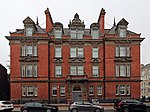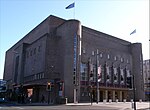Blackburne House
1844 establishments in England1986 disestablishments in EnglandAC with 0 elementsDefunct schools in LiverpoolEducation in Liverpool ... and 6 more
Girls' schools in MerseysideGrade II listed buildings in LiverpoolGrade II listed housesHistory of LiverpoolHolt familyHope Street, Liverpool

Blackburne House is an 18th-century Grade II listed building located on the east side of Hope Street, Liverpool, Merseyside, England. Originally a private house, it became a girls' school and, after a period of dereliction, it is now used as a training and resource centre for women.
Excerpt from the Wikipedia article Blackburne House (License: CC BY-SA 3.0, Authors, Images).Blackburne House
Blackburne Place, Liverpool Georgian Quarter
Geographical coordinates (GPS) Address Website External links Nearby Places Show on map
Geographical coordinates (GPS)
| Latitude | Longitude |
|---|---|
| N 53.3999 ° | E -2.9705 ° |
Address
Blackburne House
Blackburne Place
L8 7PE Liverpool, Georgian Quarter
England, United Kingdom
Open on Google Maps








